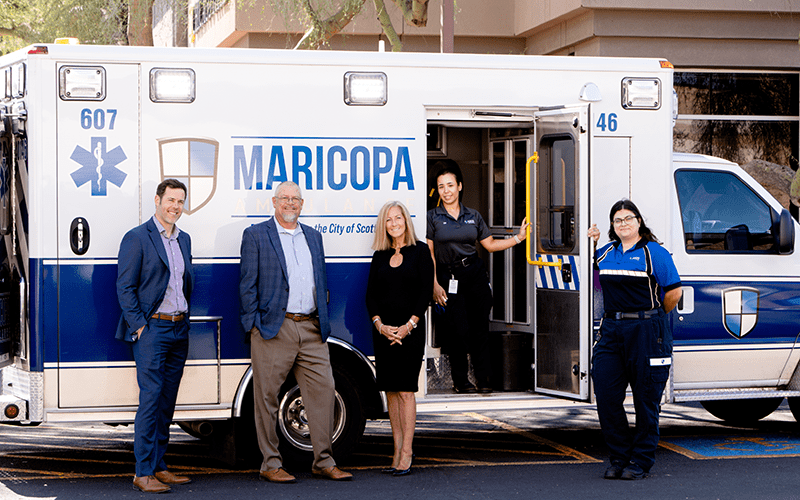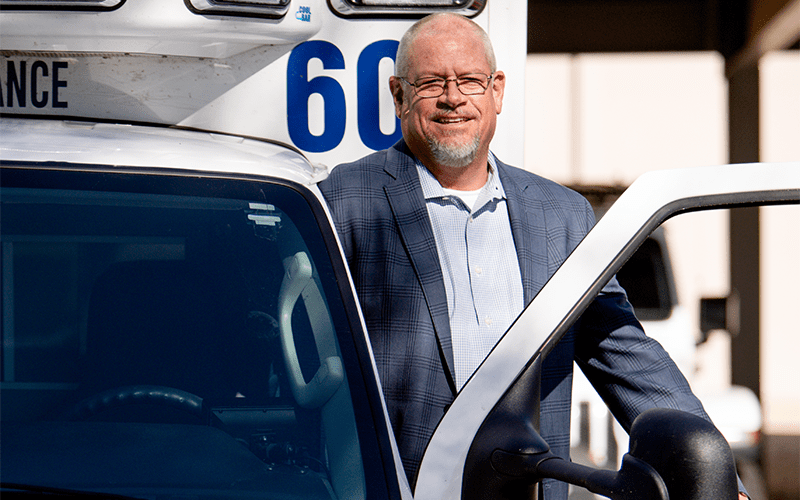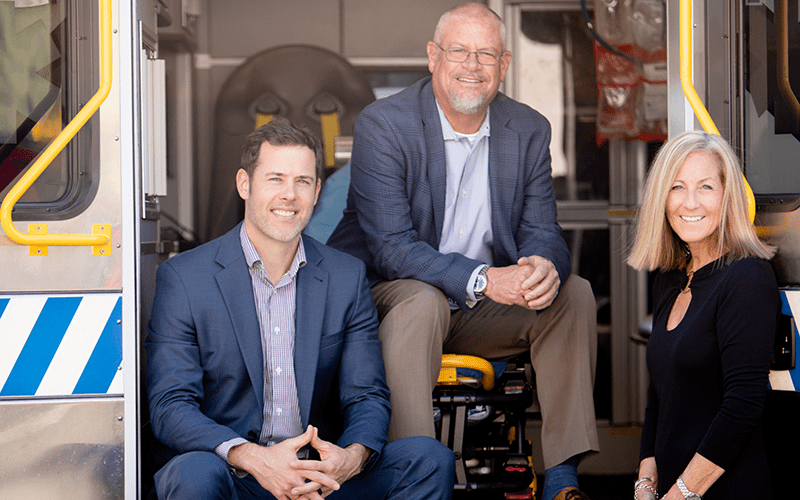Filling the gap in critical care
When people have a need to call 911, they don’t stop to ask who owns and operates the ambulance—nor should they. But when the emergency has passed, they may be surprised to learn the mobile life-saving services weren’t provided by their city or a hospital, but by a private contractor. For patients served by Priority Ambulance, that’s a very good thing, since the company fills gaps in the healthcare system where critical medical assistance may not otherwise exist.


Meet Priority Ambulance
Founded: 2013
What they do: While many large cities directly provide emergency medical services (EMS), suburbs and rural areas often work with private companies to meet their communities’ needs. Priority Ambulance is one such provider, partnering with municipalities and hospital systems to ensure residents receive timely, professional care. Today, the company operates in 13 states and manages a fleet of more than 830 ambulances and support vehicles staffed by approximately 4,100 highly trained EMTs and paramedics. In addition to responding to 911 calls, about half of Priority’s business comes from nonemergency transfers between healthcare facilities, such as hospitals and nursing homes.
How they made their mark: Priority has grown rapidly by acquiring established local EMS providers and winning new contracts with municipalities and healthcare systems. This aggressive growth strategy put Priority on Inc. Magazine’s list of Fastest-Growing Companies in America for four consecutive years, and it is now the second-largest private ambulance provider in the country.
What sets them apart: Residents in Priority Ambulance’s service areas may know the company by a different name, as most of Priority’s acquired companies have retained their original brands. “Our local operating companies have strong existing relationships and are still very much invested in their communities,” said Barker. “They have the flexibility to meet the unique needs of their customers, and now they are also supported by the capital and resources of our national team.”
Founded in 2013 by a team of entrepreneurs with a long history in the business, Priority Ambulance takes pride in partnering with municipalities and healthcare providers to deliver emergency medical services communities can count on. And that list of communities gets longer all the time. The company has experienced explosive growth in its first decade through acquisitions and new customer wins, ballooning revenue to roughly $350 million.
While growth is good, it also creates business challenges, especially in a complex industry notorious for financial gridlock.

“As we grew rapidly, we realized we were going to need a solid financial partner that could quickly adapt to our business, and BOK Financial® has been there to meet our needs every step of the way,” said Scott Barker, director of treasury for Priority Ambulance. Barker works with Stacy Sanner, treasury sales manager at BOK Financial, to help Priority control of its expansive and intricate financial processes.
“I have yet to bring a challenge to Stacy where she can’t come up with a creative solution,” said Barker.
Customized solutions for complex needs
In a way, Priority’s relationship with BOK Financial is older than the company itself. Sanner had worked with the executive team at a different ambulance company before they broke off to launch Priority in 2013. The Priority founders knew Sanner was the one to call for treasury services.

Through the years, Sanner and BOK Financial have helped the company maintain an organized and efficient treasury operation. The Priority team relies on a variety of banking products and services to optimize receivables and payables, manage working capital effectively, and maximize returns on liquid accounts.
As Priority has expanded geographically, one of its biggest challenges has been collecting and processing payments from hundreds of thousands of customers nationwide. To expedite this process, BOK Financial helped Priority establish a network of “lockboxes,” enabling customers to mail payments directly to a designated address. BOK Financial processes the receivables and streams updated data to Priority, relieving the client of a massive manual burden.
"This process can get extremely cumbersome and manually intensive. But Stacy and the BOK Financial team came up with an outstanding solution...It’s a very creative solution and is quite different from the normal outsourced payables process. It’s working quite well.”
Scott Barker, director of treasury for Priority Ambulance
BOK Financial helps on the payables side as well. “We regularly issue refunds to customers and insurers for patients whose bills may have been covered by secondary or other unknown insurance,” said Barker. “This process can get extremely cumbersome and manually intensive. But Stacy and the BOK Financial team came up with an outstanding solution in which the bank processes the refund checks and sends them back to our central billing office so additional information related to the refund can be added to the envelope. It’s a very creative solution and is quite different from the normal outsourced payables process. It’s working quite well.”

It’s a great example of how the company listens to its client’s needs and can tailor its services to solve specific problems, said Sanner. “It may not always go perfectly, but it’s the commitment and mutual trust to work through these issues together that differentiates us from the mega-banks,” she said.
As with any relationship, ongoing communication is the key to success for Priority and BOK Financial. “This isn’t a ‘set it and forget it’ arrangement. Scott and I talk at least once a week, every day when it’s necessary,” said Sanner. “Sure, we stay aligned on the business issues, but it’s also important to get to know each other and stay in touch as people.” Barker agrees. “We enjoy attending BOK Financial-sponsored events like golf tournaments or ballgames where we can bring our families,” he said. “It reminds us that even though BOK is a big company, they provide that local focus and community feel. That’s exactly what we try to do at Priority Ambulance, so that shared philosophy is one reason our relationship with BOK Financial has continued for so long.”
“This isn’t a ‘set it and forget it’ arrangement. Scott and I talk at least once a week, every day when it’s necessary.”
Stacy Sanner, treasury sales manager at BOK Financial
Automation accelerates banking processes
Companies in many industries are bogged down by mountains of paperwork, often related to billing and other financial processes. Working through a constant flow of forms is a tedious and time-consuming ordeal for human employees, but the right automated software can knock it out in seconds. That’s why so many modern organizations are using automation to save time, money and headaches, and it’s how BOK Financial helps clients streamline many banking processes.
In the case of Priority Ambulance and other healthcare providers, the back and-forth process of verifying benefits and receiving payments from insurance companies is a particularly arduous job. It’s a constant challenge to keep receivables coming in to supply adequate working capital to the business. BOK Financial is working with Priority to implement its webERA service, named for its web-based management of electronic remittance advice (ERA) files. The subscription-based software integrates with providers’ patient billing systems to automatically process and organize claims payment information, making life easier for staff members.
“It’s going to save our billing department a tremendous amount of time,” said Scott Barker of Priority Ambulance. The company is in the early stages of adopting webERA, alongside other providers like physicians’ offices, hospitals and long term care facilities. Whether in healthcare or other industries, optimized receivables management can be a shot in the arm for any company’s cash flow.
More success stories
-
Finding their tailwinds
Having enough working capital allows Aero-Zone to get planes around the world ready for takeoff.
-
Growing to serve
Discover how the Arizona Center for the Blind and Visually Impaired (ACBVI) was able to see its own campus come to life.
-
Sealing the deal
See how an extended line of credit helped this multi-generational business grow and expand.



